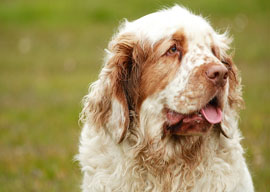
February 10, 2017

Source: Bigstock
As the breed came to be used less often in the field, it owed its survival to a handful of enthusiasts who bred for the show ring. The show clumbers tended to be heavier than their working ancestors, with bigger and more jowly heads. Recently there has been a welcome revival of interest in working clumbers, somewhat lighter and longer-legged than their show cousins. It’s probably desirable that more working-clumber blood is introduced into the show variety, because they are freer of inherited weaknesses, such as dodgy hips. Like all breeds with a small gene pool there are some congenital weaknesses, so it is important that breeders are scrupulous in their mating. Happily, all the AM1 breeders that we have had dealings with are highly responsible and devoted to their clumbers, and it’s likely that the breed will never become fashionable enough to invite exploitation. They are not dogs for everyone, certainly not for the house-proud, because they shed their silky hair abundantly. But they are utterly endearing (though they require careful management), and I can”t imagine anyone who has lived with a clumber willingly choosing a dog of another breed. The fact is, one becomes not only devoted to clumbers but besotted with them.
So when at last we felt ready to get a new dog, it had to be a clumber, partly because we knew that any other dog, however fine, would invite unfavorable comparison, as, for instance, “Yes, he (or she) is delightful, but not a clumber.” So in November Petra arrived, by courier from Norfolk, three months old and looking like a bear cub. She is very beautiful, affectionate, and intelligent, slow to leave any interesting scent, a marvelous sight at full gallop. She has still much to learn but is proving a quick learner. The dog area is occupied again, the house feels complete. The clumber may not, as I say, be a dog for everyone, but it’s the dog for us. Simply, no other would do.